P2GS Researchers 2025
Below you will find the researchers and research projects available for the 2025 Pathway to Graduate Studies Program.
 Dr. Mary Adedayo - Applied Computer Science
Dr. Mary Adedayo - Applied Computer Science
As a discipline of forensic science, digital forensics focuses on the process of identifying, preserving, analyzing, documenting, and presenting evidence from digital sources. Identifying the type of a file by its structure is an important aspect of digital forensics and computer security. Methods involving the analysis of a file header and trailer, and fragments of deleted files have been widely for this. More recently machine learning techniques have also been used. My research in forensic digital document examination focuses on authenticating digital documents using methods that have been explored for file type identification and other new approaches. We address questions such as, how do we identify the tool that created a document? how do we tell if documents have the same origin or source? Can we classify document creators based on their features using machine learning? Students in the P2GS program will work together with other students to identify and extract features for classification, learn about existing methods used in file type identification, and work towards identifying the tool (application) that created a specific type of document.
To learn more about Dr. Adedayo’s research, please visit her website: www.maryadedayo.com
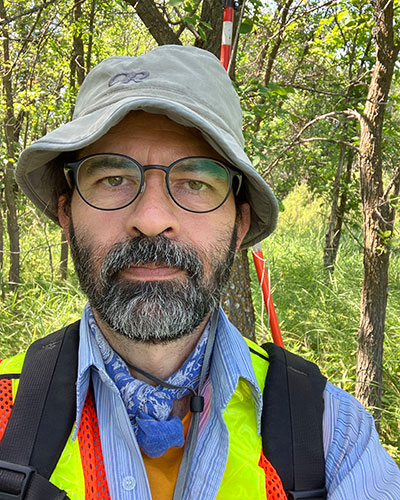 Dr. Germán Ávila-Sákar - Biology
Dr. Germán Ávila-Sákar - Biology
Urban tree fruit production in relation to foliar damage due to caterpillar feeding -
Several species of caterpillars feed on trees in rural and urban areas of Manitoba. Climate change may favour these insects, to the detriment of their host trees. In cities, greater densities of host trees than those found in their natural habitat could favour the growth of caterpillar populations. Moreover, urban areas may have smaller populations of birds, wasps and other natural enemies of caterpillars, which could also favour pest outbreaks.
In Winnipeg, preliminary studies have revealed important intra- and inter-individual variation in both foliar damage due to caterpillar feeding and fruit production of elms (Ulmus americana, Ulmaceae) and green ashes (Fraxinus Pennsylvania, Oleaceae). This variation lends itself ideally to study some of its possible causes, focussing mainly on caterpillar feeding, plant defence and resource allocation. In addition, it provides an urban perspective to plant-herbivore interactions, an important approach now that more than half of humanity lives in cities.We have been following a sample of trees within the City of Winnipeg, and another set near Beaudry Park. Tree growth is estimated from annual measurements of tree diameter at breast height (DBH). A new set of measurements in May of 2025 is needed to continue the study.
The student will develop the following skills:
• recognition of trees of each species (elms, green ashes)
• measurement of DBH
• compilation of data on a field notebook and spreadsheet
• estimation of tree growth
• citizen involvement and science / environmental education
The ideal candidate:
• enjoys walking long distances (5 - 7 blocks in an afternoon)
• enjoys outdoor work
• does not mind mosquitos
• has experience working with spreadsheets
• has flexibility to alternate fieldwork and laboratory (mostly computer) work
• wants to learn about trees and caterpillars in Winnipeg
More information about the first stage of the project: https://cankerwormwnp.blogspot.com/
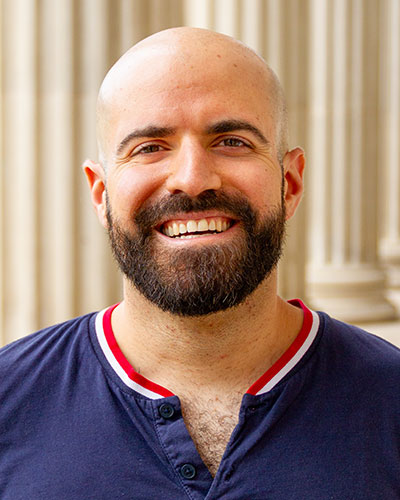 Dr. Roman Belli - Chemistry
Dr. Roman Belli - Chemistry
Main group elements (e.g. phosphorus, silicon, germanium) appear in many valuable chemicals used in society (e.g. materials, polymers, optoelectronics). On Earth these elements occur as oxides which must be processed before they are incorporated into the chemicals we need. Industrially, this involves using chlorine gas (Cl2), which apart from being a toxic and hazardous chemical, is produced via an energy-demanding process (i.e. ~9x106 metric tons/year, ~2x1010 kWh). Additionally, since some main group elements are considered endangered and/or technology critical, new sustainable methods to process them are needed. My research aims to develop Cl2-free methods to functionalize main group elements into the value-added compounds society needs. This will be achieved using efficient techniques such as photocatalysis and mechanochemistry, where light and mechanical forces promote chemical reactions, respectively. Inexpensive, easy-to-handle and abundant feedstock chemicals will be used as the functionalization partners in these new methods to make the value-added main group compounds. By obviating the need for Cl2, this research will offer more efficient, safer and less energy-intensive methods to prepare essential main group chemicals.
Students will learn synthetic inorganic and organic chemistry skills, air-free techniques (e.g. using a Schlenk line and glovebox) and spectroscopic techniques for sample analysis (e.g. NMR, X-ray).
 Dr. Nora Casson - Geography
Dr. Nora Casson - Geography
Our lab works to unravel relationships between water and nutrient cycling, to understand how patterns and processes vary across the landscape and how human activities impact the surface waters that drain forested ecosystems. We combine field work, laboratory studies and data synthesis to expand understanding of how human activities impact ecosystems, by diving deep into the mechanisms that underpin observed changes and also by looking broadly at controls on regional-scale patterns. The P2GS student will assist with building and deploying field equipment either within Winnipeg or at a forested site near Kenora and processing soil and water samples in the lab.
To learn more about Dr. Casson's research, please visit her team's website:
https://noracasson.weebly.com/
 Dr. Ed Cloutis - Geography
Dr. Ed Cloutis - Geography
We explore the solar system to understand our place in it and how life arose on Earth. Searching for life beyond Earth is a big part of exploring the solar system. In our lab, we study Earth rocks that do and don’t contain evidence of life. Rocks that contain evidence of life are called “biosignatures” (also commonly called fossils). We also study meteorites from the asteroid belt, the Moon, and Mars, to further our understanding of the history of the solar system. Me and my students are part of the Science Team of the NASA Perseverance rover that is exploring the surface of Mars, so the research that we do here finds it way to helping to explore Mars. Our study of meteorites helps us better explore and understand the Moon and asteroids – the building blocks of the solar system. P2GS students will analyze meteorites and Earth rock samples that are relevant to the search for life on Mars and understanding the origin and evolution of the solar system. For Mars, we focus on how the science instruments on the Perseverance rover can recognize biosignatures. The search for life is complicated and multidisciplinary, so students from a wide range of science disciplines can participate and contribute.
We are also part of the recently approved Canadian Lunar Rover Mission (LRM). This rover will go to the Moon in 2025, land in an area near the South Pole of the Moon and look for ice in shadowed regions. As part of this mission, we will explore places on Earth that have geological similarities to the Moon so that we can develop expertise for LRM.
To learn more about Dr. Cloutis' research, please read the article below:
UWinnipeg team supports search for signs of life on Mars
 Dr. Blair Jamieson - Physics
Dr. Blair Jamieson - Physics
I am an experimental particle physicist studying the ghostliest of particles in the standard model called neutrinos. These particles only interact weakly and can only be detected when large numbers of them pass through very large detectors. A next generation neutrino detector called Hyper-Kamiokande will be a 70-m tall, 70-m diameter cylinder of water in a large, excavated cavern in the mountains of Japan. The detector is called a Water Cherenkov Detector (WCD) as its main detection mechanism is the production of Cherenkov light from relativistic charged particles produced in the neutrino interactions. It is expected to detect several thousand electron neutrinos over a 10-year period, providing the world's best data that could discover a new source of symmetry violation. With this dataset improved studies of interactions of particles in WCD are needed, and data with known charged particles are being taken at CERN.
A student working in my group would be involved in any one of a number of projects related to the CERN beam run, Hyper-Kamiokande, or its new Intermediate WCD. This could be data analysis to study interactions in WCD or geometry calibration data taken with a set of underwater cameras. There are also raytracing studies being done to measure the geometry of the Hyper-Kamiokande detector using photographs. There are also a number of hardware projects that could be done that could include measurements of leaching into ultrapure water using a spectrometer, to mechanics for installation of the cameras on the large structures, to testing the operations of an underwater drone for measurements of the large Hyper-Kamiokande detector.
To learn more about Dr. Jamieson's research, please read the article below:
UWinnipeg Collaborates with Super-Kamiokande
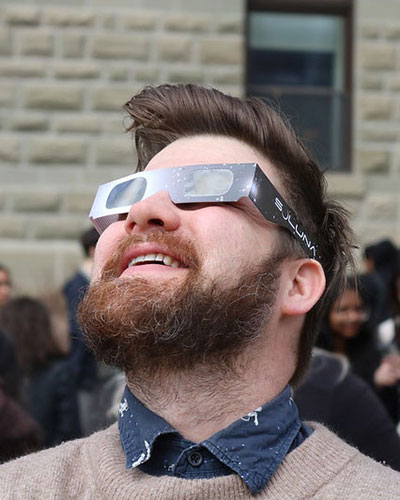 Dr. Evan McDonough - Physics
Dr. Evan McDonough - Physics
Dr. Evan McDonough is an Assistant Professor at the University of Winnipeg and the Director of the Winnipeg Institute of Theoretical Physics. Dr. McDonough applies cutting-edge theoretical physics, such as quantum fields and extra dimensions, to problems in cosmology and astrophysics, following in the tradition of such greats as Stephen Hawking and Albert Einstein. In this P2GS project, students will begin with a crash-course on topics in theoretical physics and cosmology, such as the math of curved spacetime, and how to code it into Python. P2GS students will then use equations and coding to compute the cosmic evolution of quantum fluctuations in the very early universe.
To learn more about Dr. McDonough's research, please visit their website:
Evan McDonough - Theoretical Physicist
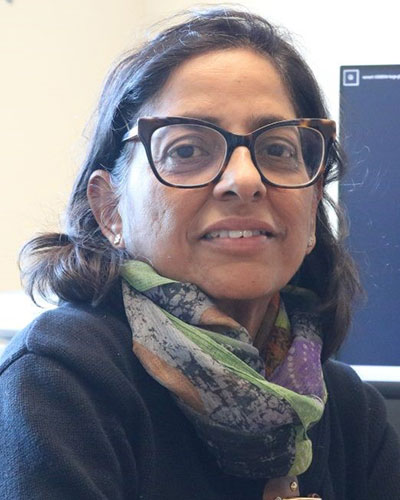 Dr. Sheela Ramanna - Applied Computer Science
Dr. Sheela Ramanna - Applied Computer Science
Social medial platforms are struggling to keep communities safe from offensive speech and misinformation. Currently, there are many AI (Artificial Intelligence) algorithms trained on several publicly curated English language datasets to address this problem. Our laboratory is involved in multimodal information processing using deep neural models in domains such as sentiment analysis, text summarization, offensive speech detection. This research project aims to give a peek into the workings of one typical learning algorithm to automatically detect offensive content. In this project, students will be given hands-on training in how language models are trained using a well-known dataset and how models learn content using open source libraries. Understanding high
resource language (ex: English) models is also key to building Indigenous language technologies.
To learn more about Dr. Ramanna's research, please visit the webpage below:
Artificial Intelligence and Machine Learning with Soft Computing
 Dr. Melanie Martin - Physics
Dr. Melanie Martin - Physics
As a physicist specializing in magnetic resonance imaging (MRI), I am developing a noninvasive empirical method to diagnose Alzheimer's disease, multiple sclerosis and other nervous system disorders earlier in the progression of the disease. I am also using MRI to follow the effectiveness of treatments over the course of time and to understand more about diseases. My program is multi-disciplinary. Students who work with me strengthen the skills they have and develop new skills in other disciplines. Projects include data analysis.
To learn more about Dr. Martin's research, please visit the webpage below:
Experimental Magnetic Resonance Imaging Physics Group
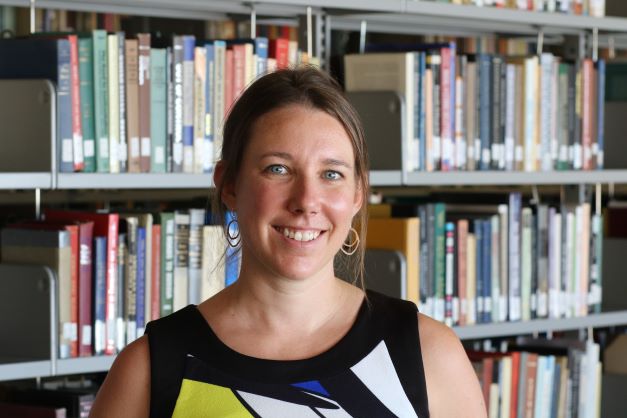 Dr. Natalie Richer - Kinesiology and Applied Health
Dr. Natalie Richer - Kinesiology and Applied Health
Aging is accompanied by a loss of balance and an increased risk of falls, which can be debilitating, costly, and damaging to quality of life. Understanding the cause of falls is essential to preventing them. In our laboratory, we use electroencephalography (EEG) to examine which brain areas are involved in balance and how their involvement changes with age. We also aim to find new ways to improve balance in the elderly population. Students who work in our laboratory will be involved in a project that examines the effect of attentional focus on postural control in healthy aging. They will be trained to use EEG and a force platform and will help in data collections and data processing. This will allow them to gain experience in neuromechanical research and learn research-related skills.
To learn more about Dr. Richer's research, please visit their ResearchGate profile:
https://www.researchgate.net/profile/Natalie-Richer
 Dr. Tabitha Wood - Chemistry
Dr. Tabitha Wood - Chemistry
How do synthetic chemists put the atoms in the correct arrangement when they make molecules? The fundamental concept in Chemistry that "structure defines function" explains how the different arrangement of atoms in distinct molecules allow for the molecules to possess unique properties. In our research lab we experiment in the area of organic synthetic methodology (not a contradiction!), which is the study of how to build carbon-containing molecules. Our studies involve exploring the nature of various organic reactions in terms of their mechanisms, what kind of molecules they can accept as substrates, and what we can do to make them reliable and predictable technologies for use in the synthesis of new molecules. With this kind of information, we can investigate ways to apply the reaction to solving problems like making the production of difficult molecules easier, and accessing new molecules with interesting new properties. A student in the P2GS program may do work ranging from gaining confidence running reactions in fumehoods to running calculations on computers (and everywhere in between), depending on their interests. This project will help students reinforce concepts they learned in Organic Chemistry, or will help them get a sneak peak at what they would learn in that course!
To learn more about Dr. Wood's research, please visit their website:
To return to the Pathway to Graduate Studies homepage, please click here.
